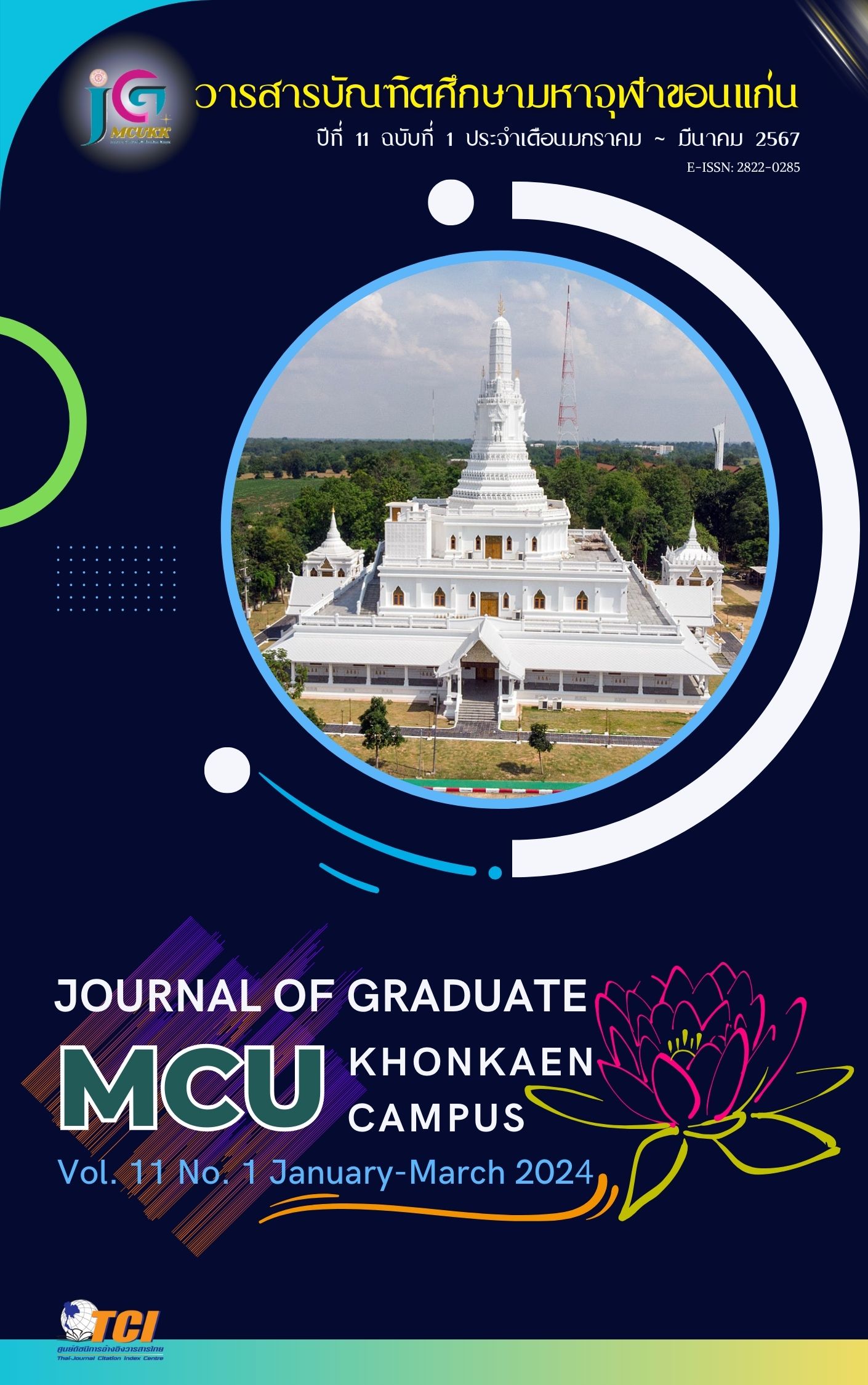The Applied Political Philosophy of King Norodom Sihanouk
Main Article Content
Abstract
The research article on the applied political philosophy of King Norodom Sihanouk has the objective s: (1) to study the concept of the applied political philosophy of King Norodom Sihanouk (2) to find out the practice of the concept of politics of King Norodom Sihanouk (3) to analyze the concept and practice of King Norodom Sihanouk’s political philosophy in the Cambodian societal context during his leadership in the period of 50s and 70s. This study was conducted by documentary research.
The research results were as follows:
1) Knowing about the concept of the applied political philosophy of the leadership of King Norodom Sihanouk, in which his leadership is based on the concept of the political philosophy of Buddhism, and follows up in accordance with the ten virtues of a leader, and four sublime states. Furthermore, it is not only ten virtues that, the study has found that King Norodom Sihanouk uses two basic concepts of philosophy: a) according to the principles of Buddhism. b) it is combined with the Brahmanism
concept, including the ancient Khmer belief system such as Totemic belief, and supernatural forces as well as to support the way of the leadership of His Majesty King Norodom Sihanouk.
2) This study reveals how King Norodom Sihanouk applied his political philosophy in the practical leadership approach and found that His Majesty King Norodom Sihanouk performed well until his common people praised him as a great King or so-called him the Righteous King or Dharmic Raja, which reflects that the practice of the ten duties of leader and the four sublime states, and this leading style can attractive of loving from the massive strongly support of the bottom of felt hearted people around the nation.
3) This study gained new knowledge from the applied political philosophy of King Norodom Sihanouk in the current social context, especially how to apply and reconcile in order for national harmony. Although respecting the neutral policy and non-aligned movement of King Norodom Sihanouk, if look at the practical knowledge from King Norodom Sihanouk, that is, flexibility in the geopolitical situation of the region and the globe is very significant mechanism to avoid the Kingdom of Cambodia from the geopolitical challenges, so the Buddhist thought was a central concept of his applied political philosophy.
Article Details

This work is licensed under a Creative Commons Attribution-NonCommercial-NoDerivatives 4.0 International License.
References
Ambassador Julio A. Jeldres. (2021). Norodom Sihanouk & Zhou Enlai. Phnom Penh: The Documentation Center of Cambodia.
Andrew Wickersham. (2019). The Political Ideology of Cambodia's Norodom Sihanouk (1945-1970). University of Arizona, 1-11.
Ang Cheng Guan. (2013). Singapore, ASEAN and the Cambodian Conflict, 1978-1991. Singapore: NUS Press Pte Ltd.
Bhikkhu P. A. Payutto. (2543 (B.E)). Dictionary of Buddhism. Bangkok: Mahachulalongkornrajavidyalaya University Press.
David P. Chandler. (1993). A History of Cambodia. Chiang Mai, Thailand: Westview Press. Inc.
Department of Press and Information of the Ministry of Foreign Affairs of Democratic Kampuchea. (1978). Facts and Evidence of the Acts of Aggression and Annexation of Vietnam against Kampuchea. Black Paper, 1-88.
Dr. Thich Nhat Tu and Dr. Thich Duc Thien. (2019). Buddhist Approach to Global Education in Ethics. Hanoi, Vietnam: Hong Duc Publishing House.
Johannes Bronkhorst. (2011). Buddhism in the shadow of Brahmanism. Netherlands: BRILL.
Julio A. Jeldres. (2005). Shadow over Angkor. Phnom Penh: Monument Books.
Julio A. Jeldres. (2015). Norodom Sihanouk and the Formulation of Cambodian Foreign Policy (1953-1976). Melbourne, Australia: Monah University Press.
Keo Baphnom. (2022). The Birth of the 2nd Kingdom of Cambodia. ក្នុង Keo Baphnom, Samdech Techo Hun Sen: Man of Cambodia's Destiny (ទំព័រ 298). Phnom Penh, Cambodia: Ariyathoar Publishing House.
Matthew J. Moore. (2016). Buddhism & Political Theory. New York: Oxford University Press.
Michelle Vachon. (2011). Norodom Sihanouk Has Always Been an Active Political Force. The Cambodia Daily, 4-15.
Milton Osborne. (1994). Sihanouk: Prince of Light, Prince of Darkness. O'ahu: University of Hawaii Press.
Norodom Sihanouk. (2021). Sommaire. Bulletine Mensuel de Documentation, 1-22.
Pann Vutha. (2014). Foundation of Khmer Philosophy. Phnom Penh: Royal Academy of Cambodia.
Rui Xu. (2020). Analysis of the Concept of Self Between Brahmanism and Buddhism. Atlantis Press, Volume 468.
Trevor Findlay. (1995). Cambodia the Legacy and Lessons of UNTAC. Great Clarendon Street: Oxford University Press.
ឈីម សេរីភូន. (២០២២). របត់នយោបាយ សីហនុ- លន់ នល់- ប៉ុល ពត- ហ៊ុន សែន ភាគ១ ភាគ២ ភាគ៣. ភ្នំពេញ: ចេញផ្សាយដោយ អ្នកនិពន្ធ.
ញ៉ែម បូរ៉ាដែន. (២០២៣). កំណត់ហេតុសង្គ្រាម រឿងរ៉ាវសន្តិភាព. ភ្នំពេញ: គ្រឹះស្ថានបោះពុម្ពឯកសារខ្មែរ.
ដៀប សុផល. (២០០៩). របបសង្គមរាស្រ្តនិយម (១៩៥៥-១៩៧០)មហាជ័យយជំនះ និងវិបត្តិ. ក្នុង ដៀប សុផល, របបសង្គមរាស្រ្តនិយម (ទំព័រ ២៩២-២៩៧).
ភ្នំពេញ: រោងពុម្ពជោគជ័យ (សុខលាភ រោងពុម្ព).
ដៀប សុផល. (២០១១). មនោគមវិជ្ជានយោបាយ ភាគ១ ភាគ២. ភ្នំពេញ: ជោគជ័យ.
នរោត្តម រណឬទ្ធិ. (២០១៧). អនុស្សាវរីយ៍ផ្អែមល្ហែម និងជូរចត់. ភ្នំពេញ: រំដួល.
នរោត្តម សីហនុ. (២០០៣). រាជសកម្មភាពដើម្បីឯករាជ្យបរិបូណ៌នៃកម្ពុជា (ទសវត្សរ៍ ១៩៤០-១៩៥០). ភ្នំពេញ: ទស្សនាវដ្តីឥន្ទ្រទេវី.
នរោត្តម សីហនុ នាយករដ្ឋមន្រ្តី. (១៩៥៩). នយោបាយទូទៅ. សារពត៌មាន អ្នកជាតិនិយមលេខ ១-២ និង ៣, ១-២៥.
បណ្ឌិត មីសែល ត្រាណេ. (១៩៩៦). ប្រវត្តិសាស្រ្ត នៃព្រះរាជាណាចក្រកម្ពុជា ព្រះបាទជ័យវរ្ម័នទី៧. ភ្នំពេញ: ការចេញផ្សាយរបស់អ្នកនិពន្ធ.
បណ្ឌិត មីសែល ត្រាណេ. (២០១៤). ប្រវត្តិសាស្រ្តនៃព្រះរាជាណាចក្រកម្ពុជា ព្រះបាទជ័យវរ្ម័នទី៧ ព្រះមហាក្សត្រគំរូ. ភ្នំពេញ: ការចេញផ្សាយរបស់អ្នកនិពន្ធ.
បណ្ឌិតសភាចារ្យ រស់ ចន្រ្តាបុត្រ. (២០១៧). សាធារណរដ្ឋខ្មែរ (១៩៧០-១៩៧៥). ភ្នំពេញ: CamED Business School.
បណ្ឌិតសភាចារ្យ រស់ ចន្រ្តាបុត្រ. (២០២៣). កម្ពុជាក្នុងយុទ្ធសាស្រ្តមហាអំណាច. ភ្នំពេញ: លន់ តុលា.
វ៉ាន់ឌី កាអុន. (២០០៨). ប្រវត្តិសាស្រ្តនៃប្រទេសកម្ពុជា ភាគ១ ភាគ២ ភាគ៣. ក្រុងប៉ារីស៍ ប្រទេសបារំាង: ការចេញផ្សាយរបស់អ្នកនិពន្ធ.
សម្តេចព្រះសង្ឃរាជគណៈមហានិកាយ ជ.ណ. ជោតញ្ញាណោ. (១៩៦៧). វចនានុក្រមខ្មែរ. ភ្នំពេញ: ការផ្សាយរបស់ពុទ្ធសាសនបណ្ឌិត្យ.
សុខ សុផាត. (២០១៤). មហាពលិកម្ម និងអនុស្សាវរីយ៍ចុងក្រោយរបស់ព្រះវីរក្សត្រ. ភ្នំពេញ: ម៉េង ហាវ.
ឥន្ទបញ្ញោភិក្ខុ ហ. មណីចិន្តា. (២០១៧). ព្រះបាទធម្មិក. ភ្នំពេញ: គ្រឹះស្ថានបោះពុម្ពផ្កាឈូក.

